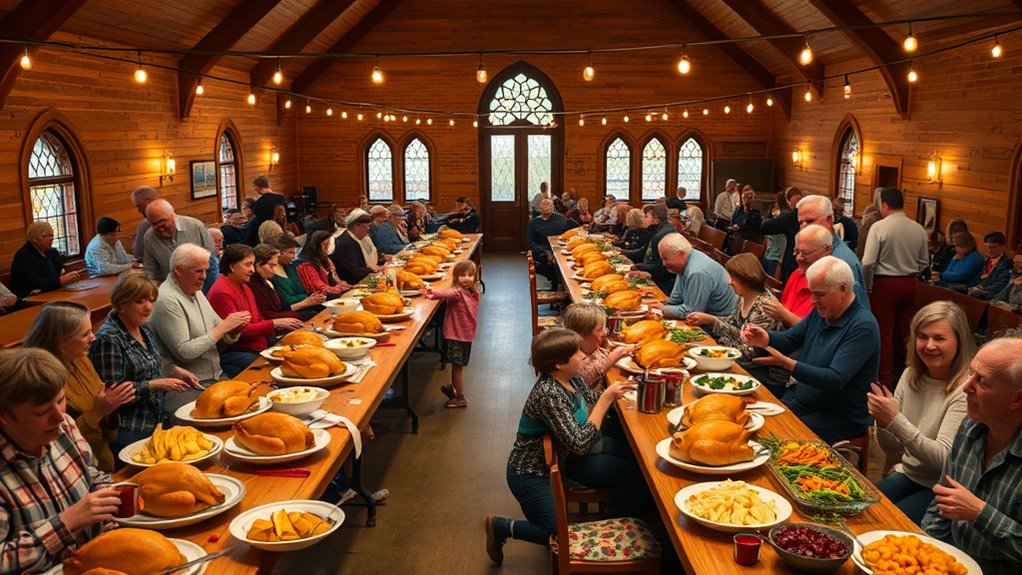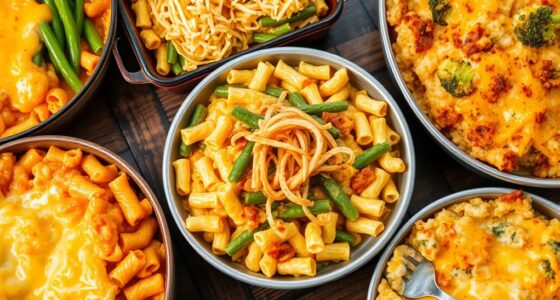Hosting a church or community Thanksgiving dinner is a wonderful way to build bonds, share gratitude, and celebrate together. Start by assembling a volunteer team and planning your menu to accommodate dietary needs while keeping it simple and hearty. Organize supplies, decorations, and logistics for a warm, welcoming environment. Focus on clear communication and recognizing everyone’s efforts. If you’re curious about more tips to make your event successful, keep exploring ways to create a meaningful gathering.
Key Takeaways
- Foster community bonds by organizing shared meals that promote gratitude, togetherness, and social connection among diverse groups.
- Recruit and coordinate volunteers, assigning roles and recognizing efforts to ensure smooth event management.
- Plan a simple, hearty menu considering dietary restrictions, with options for contributions and a buffet presentation for socializing.
- Arrange sufficient supplies, food, and beverages, optimizing layout for efficient serving and accommodating all age groups.
- Communicate clearly, prepare logistics in advance, and create a warm environment to ensure a successful and welcoming dinner.

Have you ever thought about how hosting a church or community Thanksgiving dinner can bring people together and foster a sense of gratitude? It’s a powerful way to build community bonds, offer support, and celebrate the holiday’s spirit of giving. To make your event successful, you’ll need to focus on effective volunteer coordination and thoughtful menu planning. These two elements are the backbone of a well-organized and memorable dinner.
When it comes to volunteer coordination, start by identifying who’s willing to help. Reach out to church members, local organizations, or community groups for volunteers. Assign clear roles—some can handle set-up, others serve food, while others focus on clean-up. Creating a volunteer schedule helps ensure that everyone knows their responsibilities and that no task is overlooked. It’s also helpful to have a point person or coordinator who can address issues as they arise, keep track of supplies, and motivate the team. Remember, engaging volunteers early and often keeps morale high and the workload manageable. Recognize their efforts publicly, whether through a simple thank-you note or a small appreciation event afterward.
Menu planning is just as essential. Consider dietary restrictions and preferences—offer vegetarian options, gluten-free choices, and accommodate allergies. Keep the menu simple yet hearty; classic dishes like turkey, stuffing, mashed potatoes, cranberry sauce, and pumpkin pie are crowd favorites and easy to prepare in large quantities. Decide whether you’ll cook everything yourself or solicit contributions from volunteers or community members. If you’re asking for donations, suggest specific dishes to ensure variety and balance on the table. Think about presentation as well; buffet-style setups allow guests to serve themselves comfortably and socialize more easily. Also, plan for enough serving ware, utensils, and containers to keep everything organized. Don’t forget to include beverages and possibly some kid-friendly options. If you’re hosting at a venue with limited kitchen facilities, choose recipes that are straightforward and can be prepared ahead of time.
Frequently Asked Questions
How Can We Ensure Inclusivity for Diverse Dietary Restrictions?
To guarantee inclusivity for diverse dietary restrictions, you should focus on menu diversity and allergy awareness. Offer a variety of dishes that cater to common dietary needs, like vegetarian, gluten-free, and vegan options. Clearly label each dish with ingredients and allergy information, and communicate with attendees beforehand to identify specific restrictions. This approach makes everyone feel welcome and safe, fostering a more inclusive and enjoyable Thanksgiving experience.
What Is the Best Way to Recruit Volunteer Coordinators?
You should focus on effective recruitment strategies by reaching out through various channels like social media, community boards, and local groups. Emphasize the importance of volunteer leadership and clearly define roles to attract committed coordinators. Personal invitations and word-of-mouth often yield strong candidates. Offer training and support to empower your volunteer coordinators, ensuring they feel confident and motivated to lead. This approach helps build a dedicated team for your event’s success.
How Do We Promote the Event to Reach More Attendees?
You might notice how social media and local partnerships seem to appear everywhere — that’s no coincidence! Use social media platforms to share engaging posts, event details, and reminders. Partner with local businesses, churches, and community groups to spread the word through flyers, newsletters, and word-of-mouth. This way, you reach more attendees organically, creating buzz that encourages everyone to join and celebrate together.
What Safety Protocols Should Be Implemented During Food Service?
You should implement strict food handling and sanitation protocols during food service to guarantee safety. Use gloves and hairnets, and remind volunteers to wash hands frequently. Keep hot foods hot and cold foods cold to prevent bacteria growth. Regularly sanitize surfaces and utensils, and provide hand sanitizers for guests. Clear signs about hygiene practices help reinforce safety and show your commitment to a healthy, enjoyable event for everyone attending.
How Can We Measure the Event’s Impact on the Community?
Have you thought about how you’ll measure the event’s impact? You can gather community feedback through surveys or informal conversations to see how it resonated. Tracking volunteer engagement also provides insight into your success; higher participation often indicates a positive response. By analyzing these elements, you’ll understand the event’s influence and identify areas for improvement, ensuring future gatherings are even more meaningful and impactful for your community.
Conclusion
As you prepare and serve this Thanksgiving feast, remember the spirit of the first harvest festival, where gratitude and generosity united communities. By opening your doors, you embody the timeless act of giving thanks and sharing abundance. Your efforts echo the timeless call to nourish not just bodies but hearts. In doing so, you create a sanctuary of kindness, reminding everyone that, like the pilgrims, we find true richness in community and gratitude.









